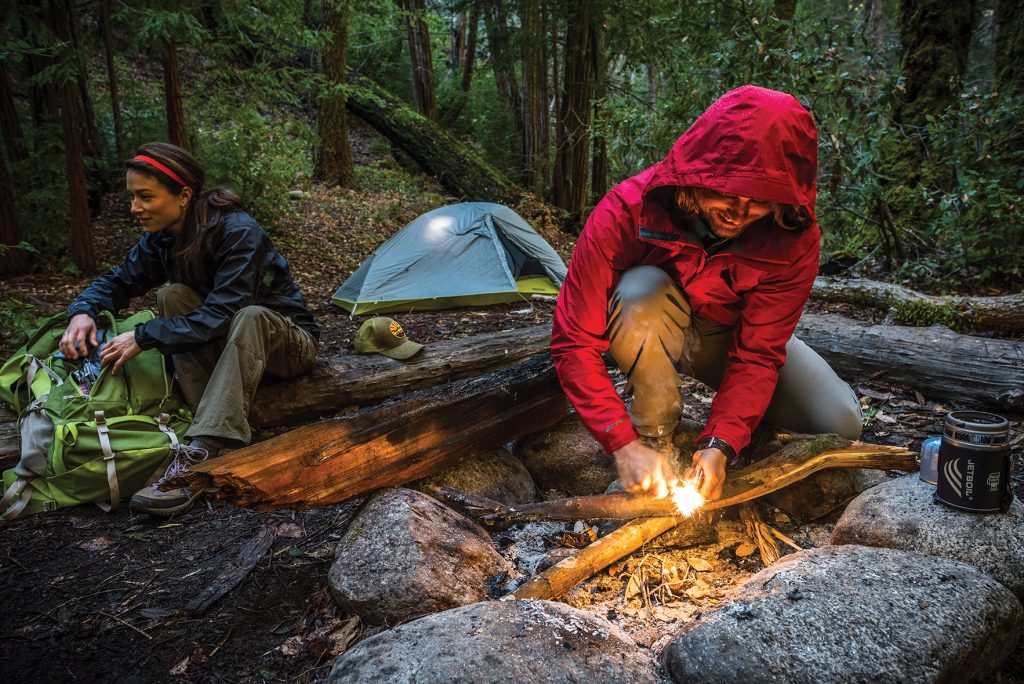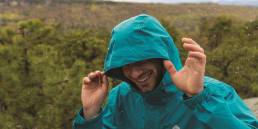You don’t want a waterproof jacket.
You heard me right. Believe it or not, you’re probably going to get wet wearing one.
If your jacket lets in absolutely no water, ever, you’re sacrificing something else pretty important. Take a fisherman’s stereotypical solid-rubber yellow rain slicks, and if you were to zip into one of those, you might as well be wearing a plastic bag or scuba diver’s dry suit. Nothing’s getting in. You could sail through a hurricane or dive 100 feet down and come out bone dry.
Why Isn’t My Jacket Waterproof?
But, if nothing’s getting in, that mean’s nothing’s getting out. If you’re standing on the crow’s nest of a ship or doing another stationary job, that might not be a huge deal, but the majority of us prefer to keep dry without being forced to stand like mannequins. While we’re hiking, skiing, or paddling, we’re also creating moisture and heat on the inside of the jacket. Thus, when you’ve got a 100-percent waterproof jacket on, that buildup can’t escape. Very quickly, we end up just as wet as if we didn’t have a jacket on at all.
Thankfully, very few jackets are actually completely waterproof, even if we refer to the category as waterproof/breathable or if we seldom get to the point where water actually makes it inside. More accurately, these garments should be called water-resistant.
Water resistance and breathability are two forces constantly at odds with one another. As a rule, to have 100 percent of either, you have to have zero percent of the other, so most jackets find a balance in between.
Both water resistance and breathability are key indicators of how well a jacket will work and how comfortable you’ll be in it, especially for active outdoor adventurers. Thankfully, metrics exist to make it easy to compare both, so you know how well it will perform before you even try it on.

Quantifying Water Resistance
Manufacturers typically rate jackets using two numbers. The first, in millimeters, describes how water resistant it is. If you were to stand a 1 in. by 1 in. tube over the jacket’s fabric, and then fill it with water, doing so would measure how high the water would have to be before it started leaking through.
In the case of a 10K jacket (or 10,000mm), you could stack a 1 in. by 1 in. column of water 10,000mm high before it even started to seep through the fabric’s other side—that’s almost 33 feet!
A rating of up to 10K is enough to handle light to average rain for a short amount of time. Ratings between 10K and 15K can handle a moderate amount of rain for much longer, and jackets rated between 15K and 20K or higher are serious shells for heavy, intense rain over a prolonged period.
READ MORE: How to Choose a Rain Shell
Quantifying Breathability
The second number, normally following the water-resistance rating, indicates how breathable a jacket is. Expressed in grams, it represents how much water vapor can move through one square meter of fabric, from inside to out, in a 24-hour period.
Up to 10K is adequate for the daily driver traveling to his or her car and back, running errands, and generally not breaking a sweat or spending too much time with the jacket on. Jackets between 10K and 15K are well-suited for someone more active or spending more time in his or her shell, like skiers.
Jackets above 15K are best for anyone doing anything active, like hiking, backpacking, snowshoeing, or ski touring. For someone working hard or breaking a sweat, anything less will feel like a garbage bag, and before long, you’ll be swimming in moisture, regardless of how water resistant it is.
So, a 10K/10K jacket, like EMS Thunderhead (men’s/women’s), can withstand 10,000mm of water per square inch from the outside, and be able to release 10,000g of water vapor per square meter from the inside—an ideal mixture for the mountain athlete.
Ryan Wichelns
Ryan was goEast's only editor from its launch in 2016 until 2023. Now, he's the founding editor of Trails Magazine, the only print publication for backpackers and people who sleep in the dirt. When he's not wordsmithing, he's skiing, hiking, mountain biking, trail running, and more in Colorado's San Juan Mountains and beyond.
Related Posts
1 Comment
Comments are closed.






Hi ! Nice explanation but i’m always wondering how can be increased the “water resistance” and in the same time “the breathability” !?